by Lisha Vidler
In this two-part article, we’ve been exploring the myths surrounding corsets. First, we looked at what corsets were designed for, and then we looked at the myths of minuscule waists, and whether or not women actually removed their ribs for the sake of a smaller waist. Now let’s examine four more myths about corsets.
Myth: Painful and Restrictive
Many historical romance novels feature characters with modern feminine ideals, women born into the wrong time, who assert their independence by casting away the dreadful inhibitions of their corsets. We’ve all seen the films where the independent heroine complains about her corset. “I can’t breathe!” she declares. “Who needs this dratted thing, anyway?”
Does this reflect reality? While there are times when a woman’s corset might feel uncomfortable—especially if it’s been laced too tight—the truth is, a well-fitted corset is generally no more painful than a modern underwire bra. In fact, some well-endowed women claim that they’d rather wear a corset than a bra, because it supports the bust from underneath, rather than allowing the weight of a large bosom to be suspended entirely from the shoulders.
Note, the key phrase here is well-fitted. A corset is designed to fit its wearer like a glove. It must be made for you, and you alone, in order to be comfortable. It’s important that the corset fit, not just around the bust, waist, and hips, but in length as well.
A properly fitted corset is designed to fit snugly, but not tight. After all, it isn’t the ribcage that’s meant to be compressed, but the fatty tissue of the waist. When the Victorian corset is laced, it squishes the fat downward into the abdomen where it won’t show. This is what allows a woman to achieve a smaller waist size than normal. If you are muscular or bony, you’ll have less to squish and will probably get little shaping from wearing a corset. There are exceptions to this rule, however. Some women who thought they were too skinny for a corset to do any good have ended up with miraculous curves—by experimenting and finding just the right cut of corset for their body.
Of course, this isn’t to say that wearing a corset doesn’t take getting used to. Victorian girls wore lightly-boned training corsets to accustom them to the enforced posture. And Victorian women knew better than to try and achieve a small waist quickly. They tightened their corsets slowly, over the course of the day, so that by evening, they might have the smallest possible waist. Modern women may well find a corset restrictive at first, especially if they try to lace it too tightly. In time, though, provided your corset fits well and is worn properly—that is, not tight but merely snug—you should be able to walk, run, sit, kneel, dance, sing, and even roll around on the ground without difficulty.
You won’t be able to bend much at the waist, however, and this is where much of the concern about corsets being restrictive comes in. Steel corset boning is flexible, but it does prevent you from bending very far. Interestingly, modern doctors recommend that you don’t bend from the waist when picking things up from the ground, but rather kneel with your back straight. Thus, wearing a corset actually encourages good posture and movement.
Now lets look at two more corset legends: the Hollywood image of women fainting or even dying because of their corsets, and the idea that women were unable to dress themselves.
Myth: Fainting, Swooning, & Dying
What of the heroine who gasps dramatically, then swoons into her lover’s arms? Is her corset responsible?
In truth, women did occasionally faint or pass out. In most cases, it was due to extenuating circumstances—an underlying health condition, overexertion, over-excitement, or overeating while wearing a corset that was laced too tight. In some cases, a woman might faint from having deliberately tightened her corset beyond what was reasonable. Then, as now, women wanted to look their best for special occasions. A modern woman might pull out the Spanx®, or she might diet prior to the big event, just to ensure that she looks as slender as possible. Women of the past were no different, but instead of wearing control-top pantyhose, they would simply lace their corsets a little tighter than usual. Combine that with an evening of rich foods and dancing, and it’s no wonder the smelling salts were occasionally necessary!
What of modern actresses who don corsets for roles in period films? There have been many interviews given where an actress talks about how she got lightheaded, or was simply in agony from so many hours laced into a corset. Some of these complaints may be exaggerated for the sake of an exciting interview, to generate interest in the upcoming film, or to highlight the sacrifices made for the sake of art. Some complaints are legitimate, though—and you may well wonder, why are these actresses in so much discomfort?
Consider that many period films rent their costumes from warehouses rather than having garments custom made for their actresses. This means the costumes won’t necessarily fit well, and remember—for a corset, proper fit is essential. Even when the costumes are custom made, the dressmakers often have to produce a great many costumes under a tight deadline. They simply don’t have the time to perfect the fit on an undergarment that might not even be seen on camera.
Add to that simple ignorance of how corsets were meant to be worn, and the pressure of needing the actress to look her absolute best—you end up with someone lacing the actress too tight, and it’s no wonder she then complains of being uncomfortable.
If fitted well and worn correctly, however, corsets are perfectly safe. That is, when worn snugly, but not tight. Many reenactors wear corsets on a daily basis, and very few have ever passed out.
Myth: Deformation
What of claims that corsets permanently reshape your body, and crush your internal organs, causing dangerous compression?
If you wear restrictive garments for long periods of time, they will shape your body. This is true even of modern clothing: witness the dips many women have on the tops of their shoulders from too-tight bra straps, or the muffin top that develops when a woman consistently wears snug low-rise jeans. This is a simple redistribution of fatty tissue, and is harmless, if aesthetically displeasing.
It’s true that a corset does apply pressure to your torso and may shift your internal organs somewhat. Your viscera are basically floating in a sac of fluid and are easily moved about. The danger lies in compressing them to the point where digestion is hindered and blood flow restricted. This can be caused by tight-lacing: a risky activity that a few still practice today. Moderate corset-wearing, however, poses little danger.
What of claims by Victorian doctors that corsets caused all manner of dangerous ailments? These ranged from indigestion to hysteria, and even death! Keep in mind, however, that these same doctors sold patent medicines containing poisonous ingredients, and they declared that warts and blindness would occur if young ladies touched themselves in a sinful way—something that is patently untrue. While well-meaning, their claims were largely unsubstantiated and, on occasion, outright lies.
Myth: Unable to Dress Yourself
Many times I’ve heard it claimed that only wealthy women wore corsets, because they needed a maid to assist them in dressing. Women of the lower classes couldn’t afford personal maids. Did this mean they couldn’t wear corsets?
First, consider what it would mean for a woman to go in public without a corset. Corsets were the historic equivalent of the bra. They were designed to support the breasts, something that most women realize is an absolute necessity. An historic woman going without a corset would be the same as a modern woman going without a bra. At best, it would be shocking, and at worst, the woman in question would be considered “loose”, immoral, and unwholesome.
Granted, some women do get away with not wearing a bra today, and it seems logical that a few did back then, too—particularly small-breasted women who don’t experience discomfort when leaving their bosoms unsupported. Today, a less-endowed woman might be able to appear in public without it being obvious that she’s without a bra; in the past, however, it would be instantly noticeable if a woman went without a corset: her posture would be different, her clothes would wrinkle and appear ill-fitting, and her silhouette would vary from the “norm”.
Could a woman, whether wealthy or poor, put on a corset by herself? Absolutely! Unless she had arthritis or some other malady that made reaching behind her difficult, there’s no reason she couldn’t lace her own corset. Of course, it’s always easier to dress with someone else’s help, if it’s available, but the only time a woman would require assistance would be if she wore a corset that had no front closure—like some from the 17th and 18th centuries.
Many extant corsets from those periods have been found that lace in both the front and back, an innovative feature that allowed a woman to dress herself. In the 1850s, the two-piece metal busk became popular, which made dressing alone much easier. To further support the concept of women dressing themselves, there are period examples of art that illustrate this.
Conclusion
We’ve looked at many of the myths surrounding corsets today. We examined the true purpose of the corset: what it does, and more importantly, what it does not do. We’ve learned that it’s not intended to make a woman’s waist impossibly tiny, nor is it meant to be painful and restrictive. If worn properly, it does not dangerously deform, nor does it cause fainting, swooning, or sudden death. Women could dress themselves easily and corsets were not limited to the wealthy.
Therefore, wear your corset with confidence and good health!
For further reading, I highly recommend the following books.
- The Corset and Crinoline: An Illustrated History by W. B. Lord
- The History of Underclothes by C. Willett Cunnington
- Underwear: Fashion in Detail by Eleri Lynn
~~*~~
What does wearing a corset mean to you? Does it symbolize the ultimate femininity, or entrapment and loss of freedom? Have you heard any costuming rumors you’d like verified, or myths you’d like dispelled?

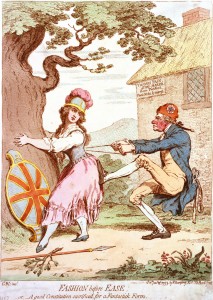
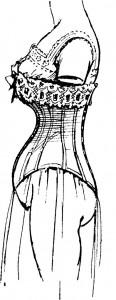
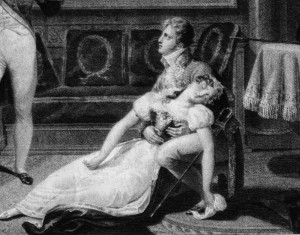
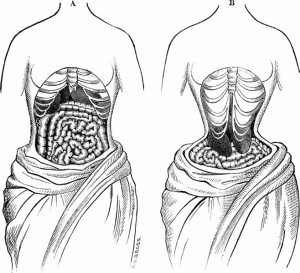
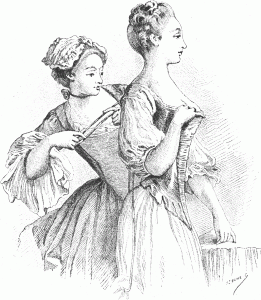
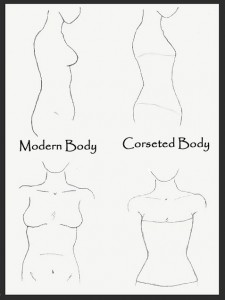
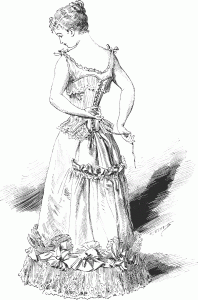
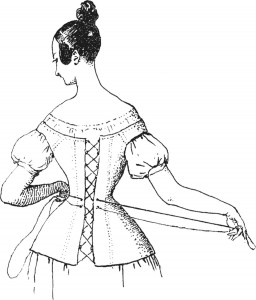
Pingback: Let’s Talk About Our Underwear ░ CloudyApples | CPU 5D
Pingback: Improving Theatrical Costumes, Part 1 – Your Ward